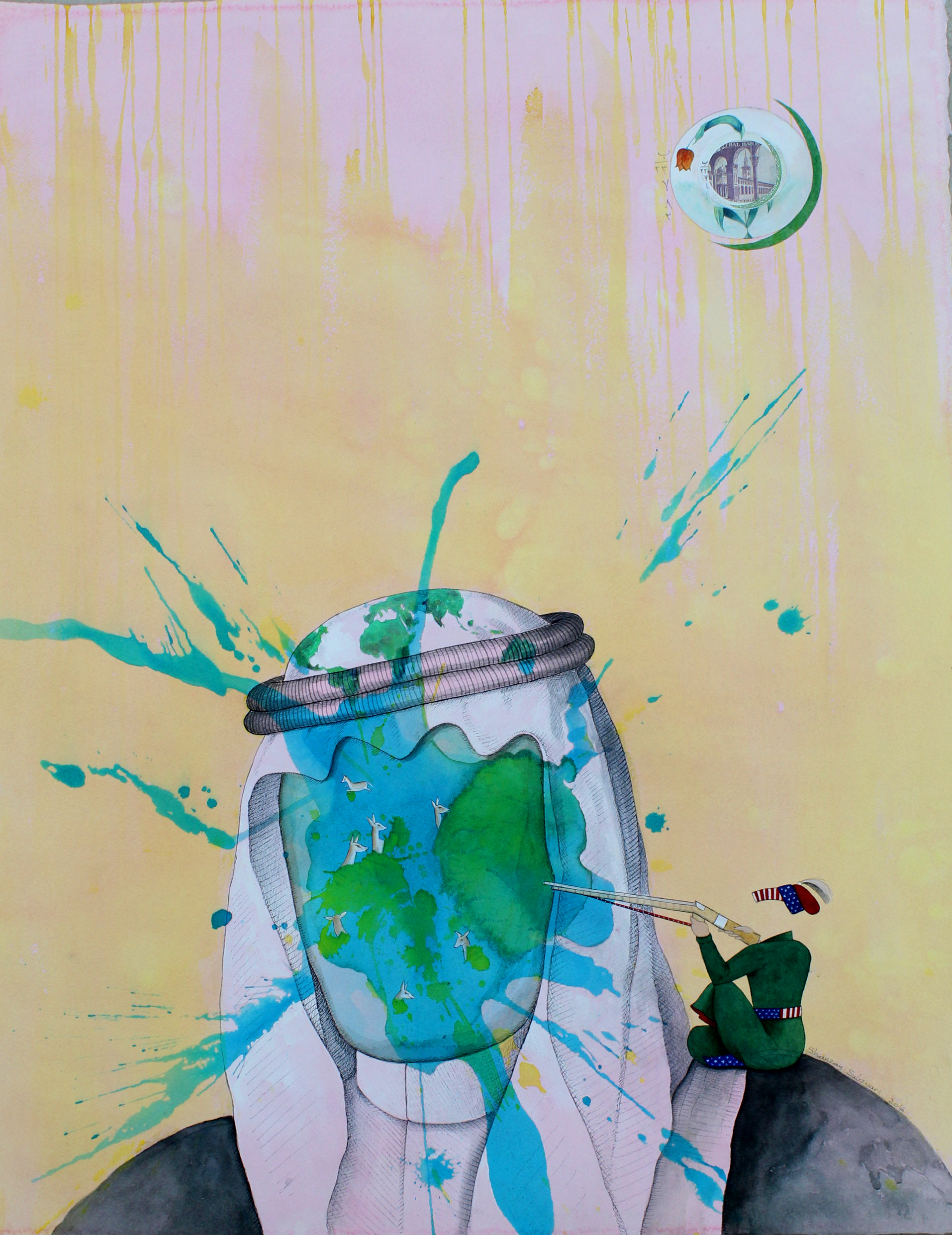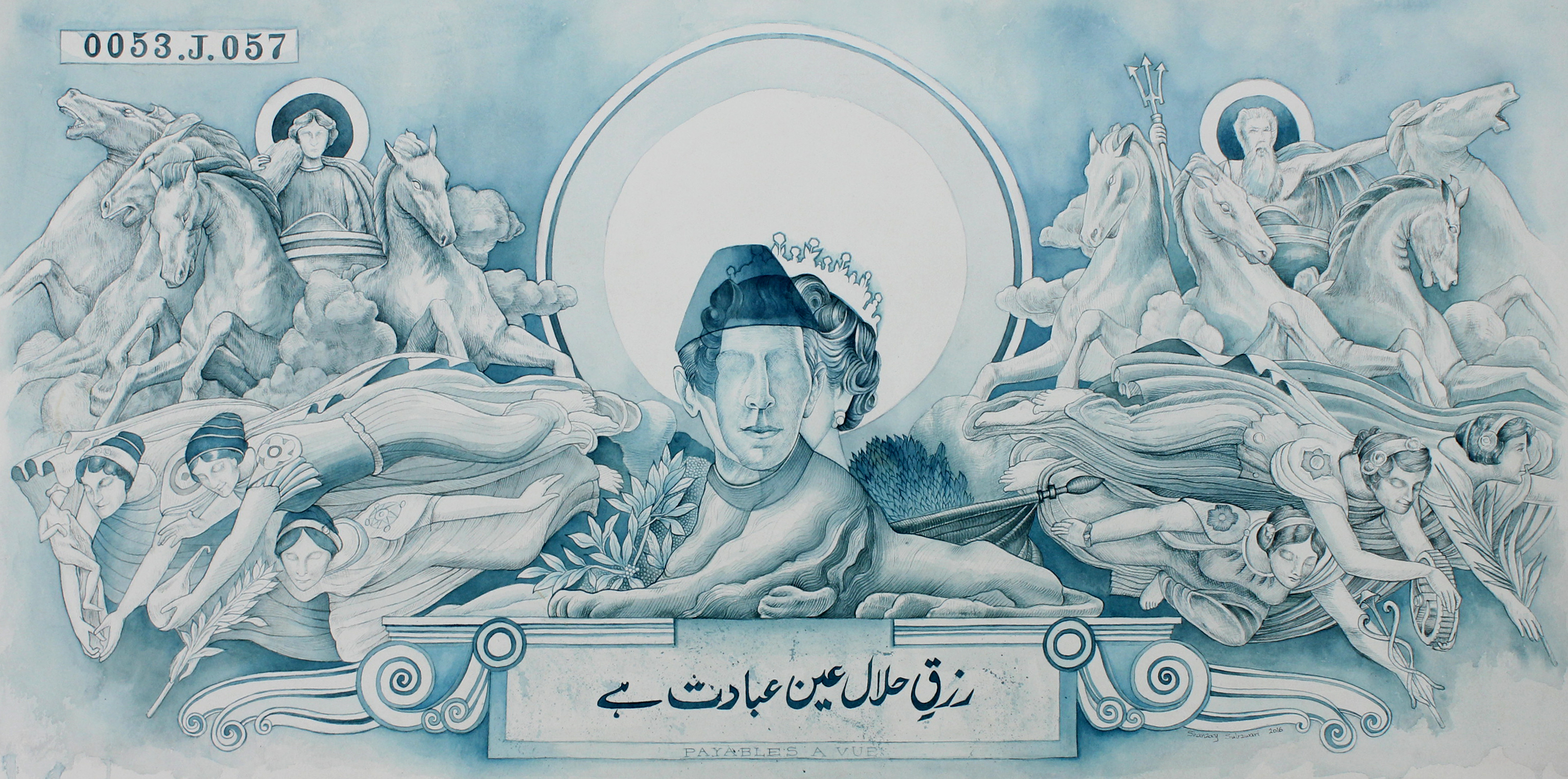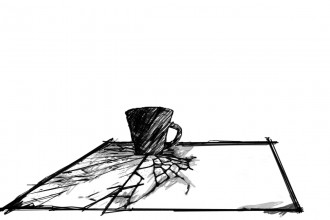Though there are flowers, cupids, the queen and castles in the sky, none seem like superfluous additions to the Shanzay Subzwari’s compositions. They are on point — not too much or too little. All the elements of the works are carefully placed on the surface of the paper as if positioned after a great thought. To further incite interest, Subzwari has found a way to marry two disciplines — painting and the traditional technique of miniatures, resulting in imagery that is exciting, and making some of us look rather foolish for insisting on drawing lines between the two practices.
The artist’s clean compositions reveal that you don’t have to inundate the canvas with lots of imagery — much can be said with very little. She simply narrates a story and leaves the viewer with the job of interpreting it. The socio-political quality of her work invites us to have a discourse about the topics both taboo and timely. Though the imagery make strong political statements, it does not take away from the aesthetic value of the work. The quality of the artwork in no way plays second fiddle to content.
The carefully structured imagery demands attention and reveals itself to be more than just social commentary. Unlike some artists, that are sometimes oblivious of what they have conceived, Subzwari is very much aware of the connotations of her imagery. Subzwari’s originality and attention to detail attracted me to her work and led to an interview where I questioned her about her work, life and her ideas about the local art scene.
Tell us a little about yourself and your practice.Â
I graduated from Indus Valley School of Art and Architecture (IVS) in December 2014 with a major in painting and minor in Indo-Persian miniature painting. Since graduation, I have taken forward the practice of miniature painting, but explored it in a more contemporary manner. So let’s say my work falls under the umbrella of ‘contemporary miniature painting’, but I experiment with mediums, sizes and surfaces.
When did you decide to become an artist?
Since I was little I have loved to draw and paint. I knew I always wanted to pursue art in some form or another, but when I was applying to IVS I sort of took a detour and applied for interior design. However, within the first two months of my foundation year I realised that my true calling was fine art, so I switched my department.
Your father is a renowned artist. I assume his practice and work life has affected you in some way. What would you say are the advantages, as well as the disadvantages, of coming from an art background?
My father began his artistic oeuvre about eight to nine years ago, and by that time I was already aware of my level of interest in the field of fine art. However, since he began painting, his level of dedication to his field, his hard work and long hours of practice have been really inspiring to me. I’m also proud of him because he does not have an artistic education; he was a civil engineer who eventually made art his career and, despite the odds, became successful at it.
I feel lucky to come from a household where art-making is a daily routine, as the environment is conducive to the creative process and encourages it. My parents are always there to support or advise me.
While there are no disadvantages as such, often my father and I don’t have the same opinion about certain works of art, which I think is okay. Also one thing I was initially concerned about was that people might begin to compare our work; however, that isn’t so, as our mediums, styles, strengths and subject matter are very different.
What would you say is the best as well as worst thing about your field?
The best thing would be the great room for an exchange of ideas on virtually anything.
The worst thing is the politics that exist, as in any other field.
How do you feel about the art that is being produced locally? Could you share the names of a few artists who you feel are producing some really good work nowadays.Â
I think Pakistani artists are incredibly talented and promising. Some of my favourites are Muhammad Zeeshan, Saba Khan, Hera Khan, Numair Abbasi, Suleman Khilji, Irfan Hasan, Abdullah M. I. Syed, Saira Wasim, Salman Toor, Khadim Ali, Aakif Suri and Mirchi Ali.
Who do you feel is getting more attention than deserved?
There is a personality on Facebook (who apparently keeps her real identity hidden) and feels the need to point fingers at Pakistani artists by comparing them with foreign artists on a purely visual basis. Her understanding of art seems to be incredibly limited, yet some people tend to become influenced by her opinions and highly superficial comparisons.
How much does society play a role in the kind of artwork that is produced?
I think a major factor it contributes to is censorship, or self-censorship by the artist. No one would like their work to be taken off a wall or receive threats when they display certain kinds of work in galleries. Since this happens in Pakistan sometimes, I think artists either become subtler with their imagery or choose not to make provocative pieces.
Society also plays a role by responding to an artist’s work, and their reaction — whether positive or negative, influences the artists’ decision to make more of such work or not. Collectors, galleries, teachers, mentors and art supporters, all play a major part by encouraging and sustaining the creative process.
Your work has a great amount of political connotation. How well is it received in a country like                           Pakistan?
While it is well-received largely, though there has been an incident where I wasn’t allowed to put my work up a day before my show because it contained an image of the Quaid-e-Azam overlapped with Benjamin Franklin (from the rupee and dollar respectively). I was disappointed, but also understood that the situation was tricky because of the political associations of the gallery.
What do you feel sets your work apart from your contemporaries?
I think my imagery that combines symbols from currency notes, Mughal miniature paintings, and most recently, Disney.
What is the one thing about your imagery that people relate to the most? What is the thing that usually remains abstract?
I think this depends on context. Within Pakistan, people can immediately connect with, and recognise, imagery from rupee notes and dollars. Abroad, people relate to currencies associated more with them than the Pakistani rupee.
I think it is the symbols from Mughal miniature paintings that I often have to explain to others, since they often have specific meanings that not everyone knows about.
What for you has been the strangest source of inspiration?
A bottle of ‘American Green’ sauce my mother brought home, thinking it was the brand ‘American Garden’, since the logos were identical. This got me thinking about the world of consumerism, and I delved into notions of how it creates a hierarchy of power, manipulation and deception. This eventually led to my exploration of currency notes along similar ideas.
What do you feel is the biggest misconception that people have about artists?Â
People think art is easy; all we have to do is make a painting and then sell it for thousands. What they don’t know is the struggle, practice and journey one has to take to be able to reach that stage. Also, being an artist is not limited to art-making; there is an entire aspect to it that involves creating relationships with galleries and other artists to strengthen ones practice.
What hurdles did you personally face as an emerging artist?
Earlier, people would ask me to make things for free and would get offended if I refused, but thankfully not anymore. I think as an emerging artist one has to be on their toes to keep making work and being relevant and recognised. It’s a constant struggle and effort.
You’re currently working on a residency. Would you like to share your experience with us?
Yes! I am currently in Fribourg, Switzerland, where I have been invited to the ten-day ‘Watch &Talk’ programme as part of the Festival Belluard Bollwerk International. Eight artists have been invited in total: from the Phillipines, India, Pakistan, Cuba, and three from Switzerland (one from Kurdistan couldn’t make it) to explore the complete festival programme “free from production constraints, free from the pressure to deliver, and free from competition†as stated on their website. The program focuses on young artists reflecting upon and questioning their own practices, on picking up new ideas and techniques, to discuss artistic projects and be involved in discourse.
It’s been an amazing experience, with the organisers being so involved in every step of our creative journey. The small town of Fribourg is beautiful and homely and I haven’t seen such varied performance art or theatre before. The main venue for the performances, the Belluard, is an ancient fortress which is hundreds of years old and enriches the entire experience, while another venue, the Ancienne Gare, is an old railway station converted into a cultural space and cafe. Here, the exchange of information between participants from different backgrounds has been such an eye-opener. Most importantly, I really treasure the friends I’ve made along the way, who’ve made me realise that no matter where we come from, everyone is really just the same.
Other than painting do you have hidden talents that you would like to share with us?
I used to sing before. Also, I used to write comic strips aimed at teenagers and children called Teen Life, that were published in Dawn, Young World. But this was a long time ago, when I was 15-17.
Usually people don’t perceive painting to be a full time career. How do you deal with questions about a possible “backup plan�
Earlier on, people used to ask my mother why she let me choose art as a career since I was so ‘smart’ and this was a waste of my abilities. Many people think art is a mindless career, easy to carry out and pursued at the artist’s whim. There is ignorance about it. However, I don’t entirely blame others, as before pursuing my BFA I didn’t know how the art world worked either.
Thankfully, my immediate family has always been incredibly supportive and as of yet, I do not need a ‘backup plan’.
What is the best advice you have been given?
No one in the art world really knows anything, so stick to making what you like and keep at it.
Lastly, what advice would you give to aspiring artists?
If one path isn’t working, take another one that works for you. There isn’t any formula for success; it comes in different ways to different people. Also, people will always have something negative to say about your work, not all will like it, so don’t get discouraged by criticism.














